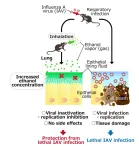(Press-News.org) Life in the ocean’s “twilight zone” could decline dramatically due to climate change, new research suggests.
The twilight zone (200m to 1,000m deep) gets very little light but is home to a wide variety of organisms and billions of tonnes of organic matter.
The new study warns that climate change could cause a 20-40% reduction in twilight zone life by the end of the century.
And in a high-emissions future, life in the twilight zone could be severely depleted within 150 years, with no recovery for thousands of years.
“We still know relatively little about the ocean twilight zone, but using evidence from the past we can understand what may happen in the future,” said Dr Katherine Crichton, from the University of Exeter, and lead author of the study.
The research team, made up of palaeontologists and ocean modellers, looked at how abundant life was in the twilight zone in past warm climates, using records from preserved microscopic shells in ocean sediments.
“We looked at two warm periods in the Earth’s past, about 50 million years ago and 15 million years ago,” said Professor Paul Pearson of Cardiff University, who led the research.
“We found that the twilight zone was not always a rich habitat full of life.
“In these warm periods, far fewer organisms lived in the twilight zone, because much less food arrived from surface waters.”
Animals in the twilight zone mainly feed on particles of organic matter that have sunk down from the ocean surface.
The study showed that in warmer seas of the past, this organic matter was degraded much faster by bacteria – meaning less food reached the twilight zone.
“The rich variety of twilight zone life evolved in the last few million years, when ocean waters had cooled enough to act rather like a fridge, preserving the food for longer, and improving conditions allowing life to thrive,” said Dr Crichton.
This led the researchers to ask what will happen to life in the twilight zone in a future, warmer world.
Combining the evidence on past warm periods with Earth System Model simulations, they simulated what might be happening now in the twilight zone, and what could happen in future decades, centuries and millennia due to climate warming driven by greenhouse gas emissions.
“Our findings suggest that significant changes may already be under way,” Dr Crichton continued.
“Unless we rapidly reduce greenhouse gas emissions, this could lead to the disappearance or extinction of much twilight zone life within 150 years, with effects spanning millennia thereafter.
“Even a low-emissions future may have a significant impact, but that would be far less severe than medium- and high-emissions scenarios.
“Our study is a first step to finding out how vulnerable this ocean habitat may be to climate warming.”
The study’s three emissions scenarios are based on total carbon dioxide emissions after 2010. “Low” is 625 billion tonnes, “medium” is 2,500 billion tonnes, and “high” is 5,000 billion tonnes.
For context, the Global Carbon Budget (led by the University of Exeter) estimated total global carbon dioxide emissions of 40.6 billion tonnes in 2022 alone.
Emissions have been close to 40 billion tonnes every year from 2010-22, so most of the carbon dioxide (about 500 billion tonnes) for the study’s “low” scenario has already been emitted.
At the current rate, the “medium” scenario would be reached 50 years from now, and the “high” in just over a century.
Dr Jamie Wilson, from the University of Liverpool, said: “The twilight zone plays an important role in the ocean’s carbon cycle because most of the carbon dioxide taken up by phytoplankton ends up there as their remains sink down from the surface ocean.
“One of the challenges of predicting how this movement of carbon might change in the future is that there are many processes to disentangle in the modern ocean.
“By looking back at the twilight zone in past warm periods we can identify the most important processes and use those to predict the future.
“We found that this natural cycling of carbon is likely already changing and may be perturbed long into the future."
To increase our knowledge on the ocean twilight zone, a UN programme (JETZON) has been set up. It states: “It is poorly understood from almost any perspective. However, it contains possibly the world’s largest and least exploited fish stock and recycles ~80% of the organic material that sinks out of the productive surface waters.”
The new study was funded by the Natural Environment Research Council and includes researchers from the universities of Exeter, Liverpool, California Riverside, Bremen, Cardiff, and University College London.
The paper, published in the journal Nature Communications, is entitled: “What the geological past can tell us about the future of the ocean’s twilight zone.”
END
Twilight zone at risk from climate change
2023-04-27
ELSE PRESS RELEASES FROM THIS DATE:
Researchers from ISGlobal and LSHTM call for incorporating heat stress indices into communication of dangerous heat waves
2023-04-27
In the summer of 2022, over 20,000 excess deaths across Spain, France, Germany and Great Britain were suggested to have been linked to extremely hot weather. In the context of global warming where climate models point to the fact that extreme heat waves are likely to increase both in frequency and magnitude, preventive measures and adequate communication of dangerous conditions take on special relevance. In a Brief Communication published in npj Climate and Atmospheric Science, researchers from the Barcelona Institute for Global Health (ISGlobal), a centre supported ...
Discovery could improve survival of bladder cancer patients
2023-04-27
· Bladder cancer is the fourth-most diagnosed cancer in men, and survival for patients with advanced bladder is less than a year
· Doctors don’t know which bladder cancer patients will benefit from immunotherapy
·Treatment of patients with ineffective therapy causes unneeded harm and delays treatment with optimal therapies
Chicago --- In a discovery that could improve the survival of bladder cancer patients, Northwestern Medicine scientists have developed a biomarker signature test to predict which ...
Odyssey of a 90-Year-Old from Israel, the United Kingdom, Australia and Singapore
2023-04-27
Down Memory Lane: Peter Ellinger’s Memoirs details the life of Law Professor Peter Ellinger, which has taken him around the world from Israel, to the United Kingdom, Australasia and finally Singapore, where he has chosen to retire. From his escape from Austria during Hitler’s reign, to his growing-up years in Israel, academia and legal practice, and his eventual retirement, this book takes you on a journey in time alongside Professor Ellinger.
Professor Ellinger is a Professor Emeritus of the National University of Singapore ...
German researchers figure out how lager first developed in Bavaria
2023-04-27
A new paper in FEMS Yeast Research, published by Oxford University Press, reveals the possible origin story of lager beers. Using historical records and contemporary phylogenomics research, investigators here show where lagers likely first originated: at the court brewery (Hofbräuhaus) of Maximilian the Great, elector of Bavaria, in Munich in 1602.
Beer has been made since ancient times. Recent archaeology shows evidence of brewing in the eastern Mediterranean some 13,000 years ago. Although from the origins of brewing until the early 20th century, ale was ...
Discovering hidden order in disordered crystals
2023-04-27
Researchers at Tokyo Tech have discovered hidden chemical order of the Mo and Nb atoms in disordered Ba7Nb4MoO20, by combining state-of-the-art techniques, including resonant X-ray diffraction and solid-state nuclear magnetic resonance. This study provides valuable insights into how a material’s properties, such as ionic conduction, can be heavily influenced by its hidden chemical order. These results would stimulate significant advances in materials science and engineering.
Determining the precise structure of a crystalline solid is a challenging endeavor. Materials properties ...
Claus Daniel to lead Argonne’s Advanced Energy Technologies organization
2023-04-27
The U.S. Department of Energy’s (DOE) Argonne National Laboratory has named Claus Daniel as Associate Laboratory Director for Advanced Energy Technologies (AET). He will begin his new role on Monday, May 1.
Daniel will join Argonne from Carrier Corporation, where he leads engineering partnerships and sustainability as part of Carrier’s strategy and innovation team. He manages the effort to decarbonize the product portfolio, with activities spanning 16 time zones in the U.S., Europe and Asia. Prior to joining Carrier, Daniel spent 16 years with DOE’s Oak Ridge National Laboratory (ORNL) in a number of roles.
“It is an exciting ...
Can jack-of-all-trades AI reshape medicine?
2023-04-27
The vast majority of AI models used in medicine today are “narrow specialists,” trained to perform one or two tasks, such as scanning mammograms for signs of breast cancer or detecting lung disease on chest X-rays.
But the everyday practice of medicine involves an endless array of clinical scenarios, symptom presentations, possible diagnoses, and treatment conundrums. So, if AI is to deliver on its promise to reshape clinical care, it must reflect that complexity of medicine and do so with high fidelity, says Pranav ...
Study shows children’s inactivity remains an issue in wake of pandemic
2023-04-27
New research has revealed children’s physical activity in the UK has largely returned to pre-pandemic levels – but children are still more sedentary during the week.
The study, led by the University of Bristol, found that by summer last year 41% of children were meeting the national recommended physical activity guidelines of an hour on average of moderate to vigorous physical activity daily. Although this shows an improvement from the immediate aftermath of the COVID-19 pandemic, when little more than a third (37%) were meeting this target, it means the majority of children were still ...
Inhaled ethanol may treat respiratory infections and stop pandemics
2023-04-27
Inhaling low concentrations of ethanol vapor can disable the influenza A virus in mice, without harmful side effects, says a new study by scientists at the Okinawa Institute of Science and Technology (OIST). The scientists believe it may also treat similar viruses such as the one that causes Covid-19.
Prof. Tsumoru Shintake, who leads the Quantum Wave Microscopy Unit at OIST, first proposed the idea to use ethanol vapor to treat respiratory tract infections. He set out to test the approach with his colleague, Prof. Hiroki Ishikawa, leader of the Immune Signal Unit at OIST, and their team members.
“Ethanol is an effective disinfectant ...
Air-breathing cathode enhances energy conversion efficiency and durability of alkaline nickel-zinc batteries
2023-04-27
Nickel-zinc (Ni-Zn) batteries are promising due to their high output voltage, high theoretical specific energy, high safety, and low cost. However, rechargeable alkaline Ni-Zn batteries are challenging, since the cathodic side reaction of oxygen evolution results in low energy efficiency and poor stability.
Recently, a research group led by Prof. YANG Weishen and Dr. ZHU Kaiyue from the Dalian Institute of Chemical Physics (DICP) of the Chinese Academy of Sciences proposed ...




